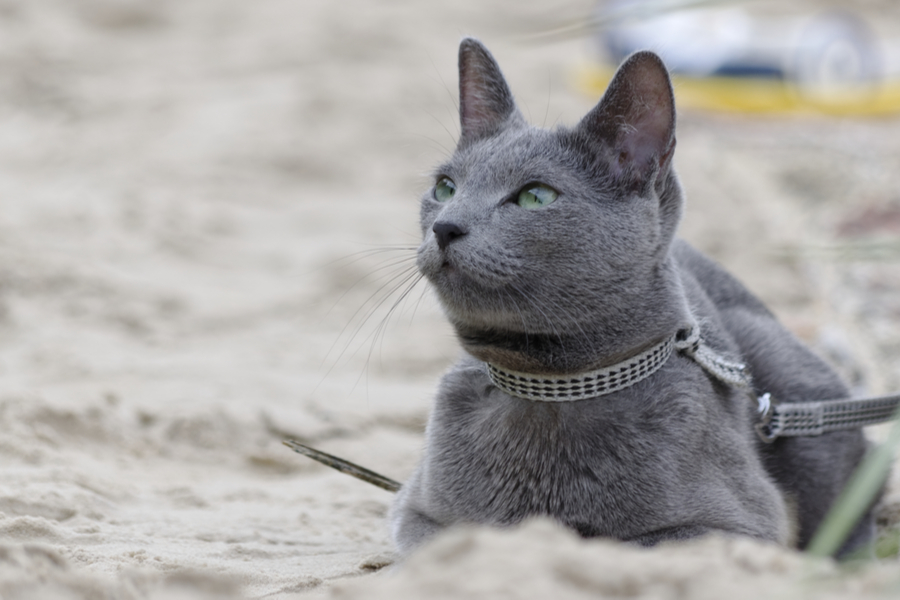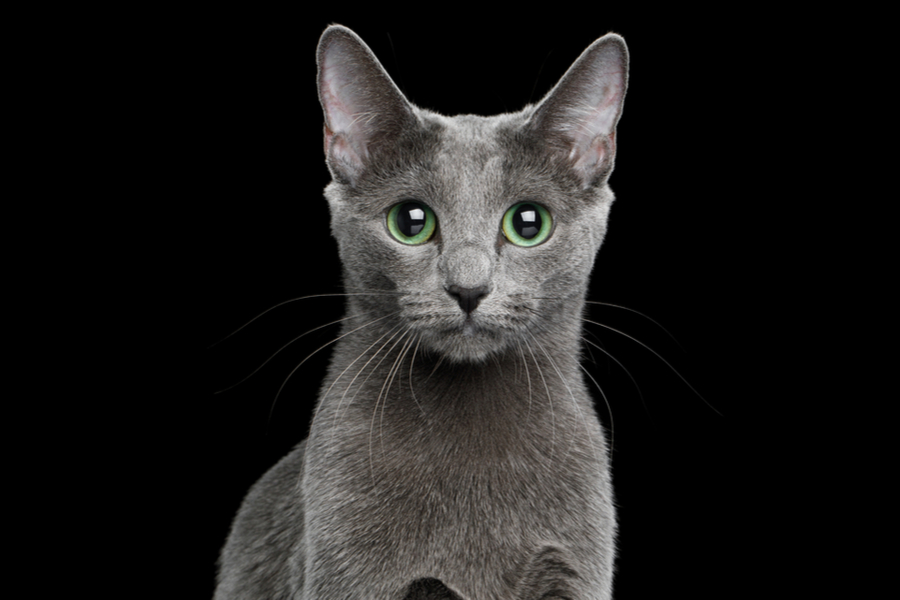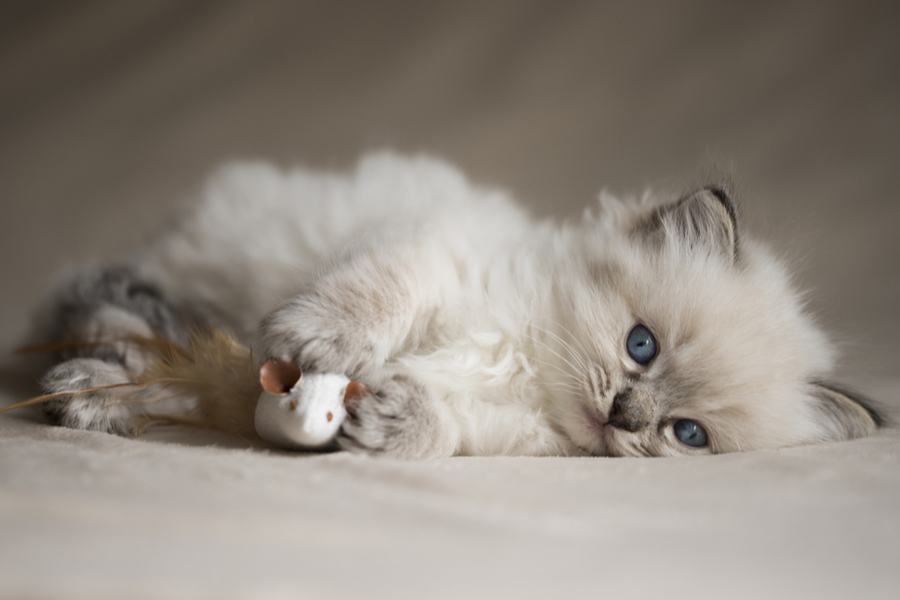Average sizes and life expectancy for this breed:
LaPerms are recognized for their curly, soft, and low-maintenance coats. They are very loving and are often found on their human companion’s lap. They also appear to understand human moods and react accordingly.
Laidback and playful, these cats form strong bonds with their families, making them excellent companions for children, those who live alone and the disabled. They love human and animal companionship and should not be left alone frequently or for long periods.
Compared to other cat breeds, the LaPerm is quite content being a lap cat. They are gentle, affectionate and will frequently follow their human companion’s lead. In fact, even if they are busy playing, once you pick them up and put them on your lap, they will stay and enjoy the affection and attention you give them.
LaPerms love and enjoy human contact. They will purr as soon as they see you. To show their never-ending love, expect them to reach for your face with their paws and rub their faces against your head or neck.
Despite their love for cuddles, LaPerm cats are not couch potatoes. They are attentive, intelligent, and energetic cats with high inquisitiveness and independence. They enjoy being involved in everything their families are doing. They can regularly be found following their human companion around their home.
These gorgeous cats are definitely different from the other breeds because of their distinct appearance and their amazing people-oriented personalities. Once a LaPerm graces your home, you may not consider other breeds again.
This cat breed captivates almost anyone who sees them. Together with their amazing appearance, intelligence and personality, it is no wonder why LaPerm is becoming one of the most popular breeds around the world.
See available kittens




In the early 1980s in Oregon, United States, Linda Koehl watched a brown tabby barn cat have a litter of six kittens. She witnessed the birth of a new “Rex” cat breed mutation as one was a skinny, hairless kitten with large wide-spaced ears and a tabby pattern showing in their skin like a tattoo. At six weeks old, the kitten developed a sparse curly shorthaired coat with a brown classic tabby pattern. The kitten was named Curly and as she grew and matured, she developed a soft wavy coat.
Over time, more curly-coated cats were born, captivating visitors of the farm who told Linda she had something special. She entered six of these cats into a cat show to see what the audience thought. From then, she began a breeding program and established her unique cats as the LaPerm breed.
The International Cat Association accepted LaPerm for a championship competition in 2002.


LaPerms can have anything from wavy to tight ringlets to long corkscrew curls. The tightest curls can be found on their underside, on their throat area, and at the base of their ears. This cat breed is a naturally occurring mutation that brings forth both short and longhaired cats.
The longhaired cat is commonly blessed with a curly plumed tail and frequently displays a full, curly ruff. Their coat is moderately soft, yet each LaPerms coat is particularly unique. The shorthaired cat has more texture to their coat than the longhaired variety. It does not have the ruff; however, they have a “bottle-brush” type tail, and their coat commonly stands away from their body, parting down the middle.
LaPerm cats come in every standard colour and coat pattern. Some kittens in a litter can be born hairless, but most of them have straight or short wavy hair at birth. LaPerm kittens frequently go virtually totally bald, starting with a spot on the tops of their heads.
This development begins typically when the LaPerm kittens are about two weeks old. Their coat will usually grow back and will always be curly if the cat was born that way. Coat variations throughout their life range from moulting that can leave a thin coat to a possible full coat after neutering or spaying.
La Perms are medium-sized with a semi-foreign type body. Their large ears make them appear alert and their long legs make it seem like they are walking on their tiptoes. Its coat texture is distinctly different compared to any other Rex mutation, and it varies within the cat breed. All colours are acceptable, including tortoiseshell, tabby, red, calico, or black.
Their whiskers are long and curly. Their ear furnishing and eyebrow hairs may also appear curly and may grow long enough to curl into their eyes. The ideal LaPerm will have a moderately soft but textured coat that is loose and bouncy, standing away from their body, resembling a “Gypsy Shag”. Their coat should be free of matting and should not be too thick or heavy.
LaPerm cats are gentle and loving but also very energetic. Compared to other active breeds, the LaPerm is quite happy to be a lap cat. They seek human touch and will purr as soon as they notice your presence.
They are curious by nature and will always want to know what is going on in their surroundings. LaPerm cats will reach for your face with their paws and rub their faces against your neck, head, and face.
LaPerm cats remain energetic and playful throughout adulthood, but they will never miss a chance to cuddle up on their human companion’s lap or around their neck. Ping pong balls and toy mice are recommended, and a tall cat tree so they can jump and climb to supervise the surroundings.
LaPerm cats are different from any other cat breed because of the unique combination of their appearance and people-oriented characters. Once a LaPerm cat graces your home, you will have a hard time thinking of living with any other cat breed, and you may find it essential to have more than one.


Because of their intelligence and inquisitive nature, LaPerms are easy to train. Start them early by teaching them simple tasks like using the scratching post and litter box. As they grow, you can teach them more complex commands, tricks, and games, such as retrieving games and playing fetch.
It is vital for LaPerms to play interactive and puzzle toys to inspire their bright minds continuously. Remember to provide treats when they obey a command, perform a trick, or just by simply behaving during their training sessions.
When a LaPerm cat is properly trained and familiarised at an early stage, they will thrive into being a well-behaved and well-rounded family pet.
Their coats are low shedding, light, and hardly matt or tangle since they are without a heavy undercoat. Using a wide-toothed comb to brush them is ideal; however, bathing and brushing are not needed as they are meant to appear a little untidy.
Their curly coats are lighter during summer as they lose some of their undercoat and fur on their neck for coolness. Meanwhile, in winter, mature Longhair LaPerms will have a full ruff and plumed tail. Short Hair LaPerm cats are not as affected seasonally and have a springy feel and a bottle brushtail.
To keep their coat healthy and in tiptop condition, train them to get used to grooming as early as kittenhood. Use a very soft brush to gently groom their coat and eliminate dead hairs and dirt from accumulating. Make it an enjoyable experience for your LaPerm so they effortlessly submit themselves for grooming. As part of their training, reward them for good behaviour to encourage them.
Examine your LaPerm’s ears, and eyes as these two can be prone to infection. To keep their ears clean and healthy, check for any debris, dirt or wax buildup. You can wipe it out using clean cotton balls and an ear cleanser. Remember not to use cotton swabs, which can irritate or damage your cat’s inner ear structure. If you notice any foul odour coming out of their ears, call your vet immediately for care and treatment, as this can be an indication of infection.
For their eyes, keep them clean by checking them weekly for dirt, stains and discharge. You can use a clean, soft fabric with a vet-approved eye cleaner to remove any stains or discharge that may lead to infection. Just remember to use a different part of the cloth to prevent any risk of eye infection.
For their dental health, brush your LaPerm’s teeth weekly to avoid tartar buildup and tooth and gum diseases. Use a vet-approved pet toothbrush and toothpaste to clean their teeth and mouth effectively. To clean their nails, trim them regularly, as often as twice a month or as needed. Check their paws as well to see if it is healthy, injury and dirt-free.
Make sure that their litter boxes are always clean. Because of their unique curly coat, dirt, debris, and clumped litter can cling to their fur and might be hard to remove. Also, they may ingest these matters, which can cause irritation and blockage to their digestive system. Moreover, soiled litter boxes will push your LaPerm to use other areas of the house for their business.
Lastly, it is best to keep your LaPerm as an indoor pet. This will keep them safe from acquiring feline diseases or getting in accidents or animal attacks. In addition, keeping them indoors will prevent them from being captured by passers by who are captivated by their unique beauty.


Being a relatively new cat breed, LaPerms do not have breed-specific diseases, except Pyruvate kinase Deficiency (PKD) deficiency, which has been identified in this breed. A DNA test is available for breeders to screen their cats and avoid mating two carriers.
Another thing to consider is that cats with wire coats can have oily skin than those with normal coats. Oily skin can become itchy and may be prone to yeast infections, so this is something to keep an eye out for.
The International Cat Association 9TICA) LaPerm Breed Committee endorses all breeders to conduct DNA tests on all permitted domestic outcrosses before being introduced into the breed pool. Therefore, we strongly suggest you only consider a breeder who runs DNA health checks on their cats and will show you the results.
LaPerms love receiving attention and interacting with their families. That’s why they make an excellent feline companion for families with children and other pets. Their playfulness is a match for children as they can be taught to play fetch and other interactive games. Just make sure to supervise their interaction to avoid any accidents such as coat pulling or mishandling.
Bringing a LaPerm into a home with other pets is easy as they can live harmoniously with other cats and cat-friendly dogs. Still, remember to introduce them gradually in controlled areas to make sure that they learn to get along well first.


We can connect you with Breeders that are specialized in this particular breed.
See available kittens
United Kingdom
Size : Small
Coat : Short
Registration : GCCF, TICA, CFA, FIFe
Vocality : High
Hypoallergenic : Yes
Grooming : Once a Week

United Kingdom
Size : Small
Coat : Short
Registration : GCCF, TICA, CFA, FIFe
Vocality : Low
Hypoallergenic : Yes
Grooming : Once a Week

United States of America
Size : Medium
Coat : Short
Registration : GCCF, TICA, CFA, FIFe
Vocality : Low
Hypoallergenic : No
Grooming : Once a Week

United States of America
Size : Medium
Coat : Long
Registration : GCCF, TICA, CFA, FIFe
Vocality : Low
Hypoallergenic : No
Grooming : Twice a Week


Need some advice?
Whether you're a first time pet owner, an experienced pet owner, a new or long-time breeder, or just curious about pets, we've got you covered!

January 17, 2024
What Is The Personality Of Russian Blue Cats?
Russian Blue cats are most known for their distinctive shimmery blue-silver coat and piercing green eyes. However, this breed’s calm and gentle temperament is what makes them shine the most in the feline world.

January 17, 2024
10 Facts About Russian Blue Cat Breed
Russian Blues are one of the most aesthetically stunning cat breeds, with a gorgeous plush silvery coat and vibrant green eyes. However, it’s not only their appearance that is beautiful; their nature is too.

January 17, 2024
How To Choose The Right Cat Breed for You
Cats can make the most fantastic animal companions; they are adorable, friendly, and loving. However, not all felines are created equal. There are many different breeds, of which each has its unique personality traits.
Need some help?
Contact us to speak to our friendly advisor, who will gladly help you find your dream pet!



We are registered in England and Wales under registration number 12568840,
and our registered office is at 58-60 Kensington Church Street, W8 4DB London, England.
© 2023 The Pedigree Paws